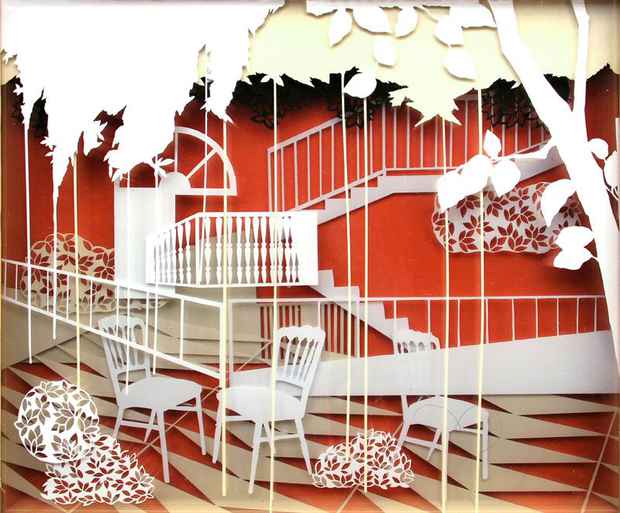"Méré Humd(r)um" Exhibition
Aicon Gallery

This event has ended.
Aicon Gallery New York presents Méré Humd(r)um, a group exhibition of Contemporary art from a new wave of young Pakistani artists. The Urdu word Humdum, one syllable removed from its mundane English cousin, means someone who is so close that their breath and yours are one. The word Méré, with even less separating it from the minimal, almost pejorative, “mere” of the English language, is infused with belonging - it means mine. Together, Méré Humdum becomes a term of endearment for a mentor, a friend or a lover. But in a linguistic coincidence it is just a syllable away from the English “mere humdrum.” Today, more than sixty years after Pakistan’s independence, the ordinary, the everyday, the humdrum, remains an object of longing for most Pakistanis - the type of longing one might reserve for a lover. A day when there is no bombing, no violence on the streets - a day when the school bus is delayed only by traffic is a day of thanksgiving and celebration. The twelve artists in this exhibition have created work in direct response to the chaos and violence surrounding them, yet much of this work is imbued with an intrinsic and eternal optimism that stands in defiant contrast to the instability and uncertainty from which it has emerged.
Much like Germany’s Weimar Republic of the 1930s, an odd dichotomy is in place with today’s generation of young Pakistani artists. While on the one hand, their political, economic and social situations are spinning out of control, the visual arts, in this landscape of circumscribed opportunities, is undergoing a transformation and creative flowering never before seen. This younger generation largely departs from the more traditional methods of their artistic heritage, such as miniature painting, and combines local materials and themes with progressive modes of post-colonial art practice, offering new interpretations and posing new questions for a society mired in political turmoil, social upheaval and violence both foreign and domestic.
Abdullah M. I. Syed’s Flying Rug works arise from Oriental myths and legends of the flying carpet and our desire for instant gratification. Made of folded U.S. dollar bills and box-cutter blades assembled into squadrons of drone-like airplanes, the rugs reference the dark and multilayered political implications of terrorism, capitalism and American hegemony, yet are intertwined with a poetic counterpoint that transmutes them and charges the works with the phenomenal capability of a magic carpet or the sublime stillness of a prayer rug. The works question not only the roots and consequences of 9/11 and the ongoing War on Terror through the prism of oversimplified Eastern and Western perceptions of one another, but also the complex relationship between capital and Contemporary art.
Cyra Ali’s haunting sculptures of disembodied intertwined limbs adorned in bright fabrics obtained from Karachi bazaars are a daring subversion of the overtly clad female body of Islamic tradition. The work stems from her desire to overturn the conventional trappings of femininity in Pakistani society and combat longstanding patriarchal desires to repress female sexuality. Ali’s bizarre doll-sized mash-ups of female legs blur the line between the most ordinary of body parts and the sinister and monstrous proportions they are capable of taking on when continually contextualized as taboo objects of desire to be both coveted and suppressed. More straightforwardly, Sarah Khan’s art is born from her resolute devotion to Pakistan, her beloved State, and her desire to see its artistic traditions, mainly miniature painting, evolve to address the socio-political complexities of its contemporary reality. She addresses her humdum (her Pakistan) for its charm and fading glory as she fortifies her wish for its resurrection from a negative entity to a positive one.
Ehsan Ul Haq creates Duchampian assemblages of found everyday objects in which the individual components, though ordinary enough, are re-contextualized as dysfunctional or symbolic elements in what he calls “flawed systems.” Ul Haq sees his installations as operating “on a plane where art and life exist as parallels within ambiguous forms.” Through installations such as Fan and Water, man-made objects are stripped of their utility and repurposed in creations demonstrating both man’s god-like ambition to create new systems of life and the resulting absurdities brought into being when such attempts misfire.
Ultimately, this exhibition presents an examination of how a new generation of Contemporary Pakistani artists, through a range of disparate media and practices, continue to develop new methods of questioning the space between art and life in the often violent and chaotic reality they are faced with every day. Their work addresses not only the chasm and interstices between the two, but the extraordinary possibilities of art created in extraordinary surroundings.
[Image: Seher Naveed "EVENING CONVERSATIONS" (2011) Paper cuts, 15 x 18 in.]
Media
Schedule
from January 26, 2012 to February 25, 2012
Opening Reception on 2012-01-26 from 18:00 to 21:00